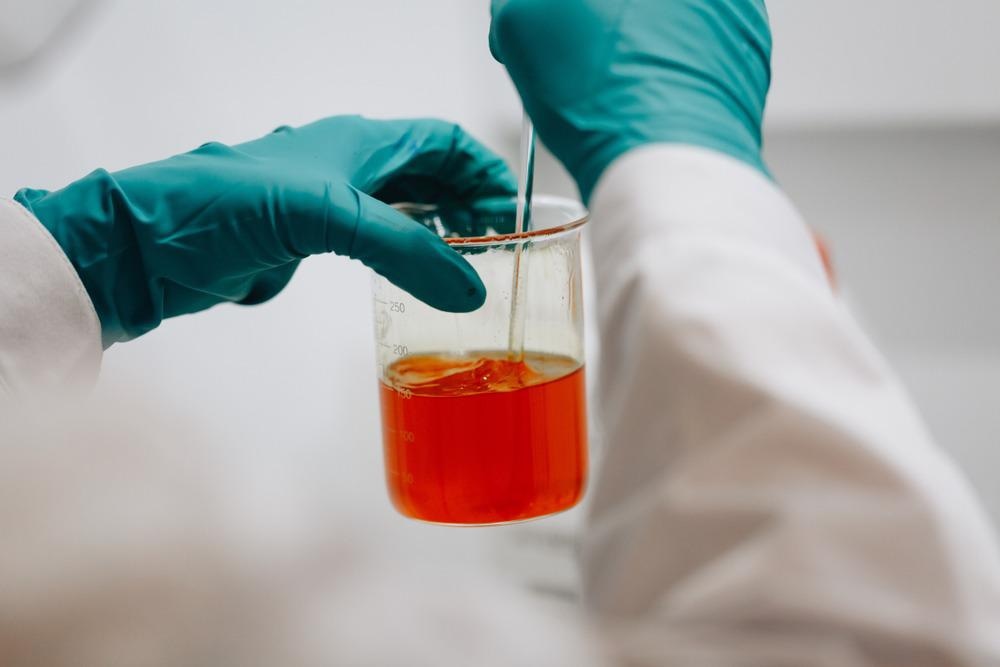Rhodamine 6G (R6G) is hazardous to humans and the environment. In an article recently published in the Microchemical Journal, researchers designed water-stable perovskite quantum dots and a fluorescence resonance energy transfer (FRET)-based fluorescence nanosensor to detect R6G in food, water, and biological buffers.

Study: Water-stable Perovskite Quantum Dots-based FRET Nanosensor for the Detection of Rhodamine 6G in Water, Food, and Biological Samples. Image Credit: kirill guzhvinsky/Shutterstock.com
The prepared nanosensor had good sensitivity and selectivity, and the encapsulated perovskite QDs had enhanced aqueous stability over non-encapsulated counterparts.
R6G and Fluorometric detection
R6G is a xanthene dye derivative, a color additive extensively used in the textile and food industry. However, exposure to R6G leads to irritation to the eyes, skin, and respiratory tract and causes retinal ganglion cell impairment. In severe cases, R6G has carcinogenic effects in humans and animals. Hence, R6G is banned from food industries in a few countries.
The harmful effects of R6G call for a facile and rapid screening method for R6G detection. Although mass spectrometry, ultraviolet spectrometry, and liquid chromatography can detect R6G, these methods are time-consuming, expensive, and require an expert for equipment operation.
Fluorometric detection is a popular sensing approach that entails different aqueous-based fluorophore types like upconversion nanoparticles, semiconductor quantum dots, transition metal-based dichalcogenide quantum dots, and carbon-based quantum dots. These fluorophore materials have advantages like high quantum yield, tunable emission, outstanding photostability, and broad absorption spectra.
The fluorescence sensing mechanism requires minimal sample preparation and is a simple process. The FRET-based fluorescence sensor is a precise and effective sensing mechanism with a ratiometric fluorescence response than fluorescence enhancement or quenching.
The superior electronic and optical properties of perovskite QDs received considerable attention for their optoelectronic applications like light-emitting diodes and solar cells. Although perovskite QDs have high absorption, tiny full-width half-maximum (FWHM), high photoluminescence quantum yield (PLQY), charge carrier mobility, long charge diffusion range, high crystallinity, and defect-tolerance, they are sensitive to light, moisture, oxygen, and high temperatures.
FRET-based Fluorescence Nanosensor for R6G Detection
In the present work, the authors employed phospholipid and silica co-encapsulated cesium lead bromide (CsPbBr3) QDs as a ratiometric FRET-based fluorescence nanosensor to detect R6G in water, food, and biological samples.
The green emission signal of the nanosensor at 518 nanometers decreases in the presence of R6G and a new peak at 565 nanometers, which indicates a typical ratiometric fluorescence relationship. Moreover, the proposed nanosensor was selective toward R6G.
Transmission electron microscope (TEM) images show that PEGylated CsPbBr3/ silica (SiO2) QDs have uniform size of approximately 30 nanometers and dynamic light scattering (DLS) analysis showed the hydrodynamic size of PEGylated CsPbBr3/SiO2 QDs of 29 nanometers. The initial average size of CsPbBr3 QDs of 10.8 nanometers was increased to 30 nanometers due to phospholipid encapsulation, which can be observed through the photoluminescence (PL) spectrum.
Furthermore, the red shift in emission spectra corroborated with the increasing nanocrystal size. Powdered X-ray diffraction (XRD) spectrum showed the orthorhombic phase of CsPbBr3 and the minor peaks between 2θ of 20 and 30 degrees originate from PEGylated amorphous silica shell on CsPbBr3/SiO2 QDs.
Fourier transform infrared spectroscopy (FTIR) revealed the functional groups of PEGylated CsPbBr3/SiO2 QDs. Pure CsPbBr3 QDs exhibit carboxyl (COO-) peaks from the oleate species, C=C hydrocarbon group, and C=C-H group at 1498, 1679, and 2922-centimeter inverse respectively. Further, silica encapsulation on bare CsPbBr3 QDs results in new peaks of silicon-oxygen-carbon (Si-O-C) and Si-O-Si at 1060 and 1188-centimeter inverse, respectively. The PEGylation of CsPbBr3/SiO2 QDs results in the appearance of hydroxyl (OH) groups at 3342-centimeter inverse, suggesting excellent aqueous stability and solubility of QDs.
The selectivity of PEGylated CsPbBr3/SiO2 QDs towards R6G and other color additives was evaluated using an intensity ratio (I565 /I518). The spectra showed a prominent I565 /I518 ratio compared to other color additives. The authors observed a slight interference due to fluorescein, which is attributed to the overlapping of fluorescein’s fluorescence properties with R6G. However, the results showed a significantly lower response to fluorescein compared to R6G.
Conclusion
In summary, the authors developed water-stable PEGylated CsPbBr3/SiO2 QDs containing FRET-based fluorescence nanosensor for selective and sensitive R6G detection in water, food, and biological samples. The authors demonstrated that the donor species was PEGylated CsPbBr3/SiO2 QDs and the acceptor species was R6G.
Ratiometric photoluminescence (PL) spectral responses attained for PEGylated CsPbBr3/SiO2 QDs in the presence of R6G of varied concentrations revealed a considerable detection limit of 0.01 microgram per milliliter, indicating their high sensitivity.
Despite potential interfering species, employing PEGylated CsPbBr3/SiO2 QDs as ratiometric fluorescence sensors in water and food samples showed good accuracy. Finally, the authors evaluated the stability of PEGylated CsPbBr3/SiO2 QDs was higher than bare CsPbBr3 QDs.
Reference
Chan, K. K., Yap, S. H. K., Giovanni, D., Sum, T. C., and Yong, K. T (2022). Water-Stable Perovskite Quantum Dots-Based Fret Nanosensor for the Detection of Rhodamine 6g in Water, Food, and Biological Samples. Food, and Biological Samples. Microchemical Journal. https://www.sciencedirect.com/science/article/pii/S0026265X22004520
Disclaimer: The views expressed here are those of the author expressed in their private capacity and do not necessarily represent the views of AZoM.com Limited T/A AZoNetwork the owner and operator of this website. This disclaimer forms part of the Terms and conditions of use of this website.